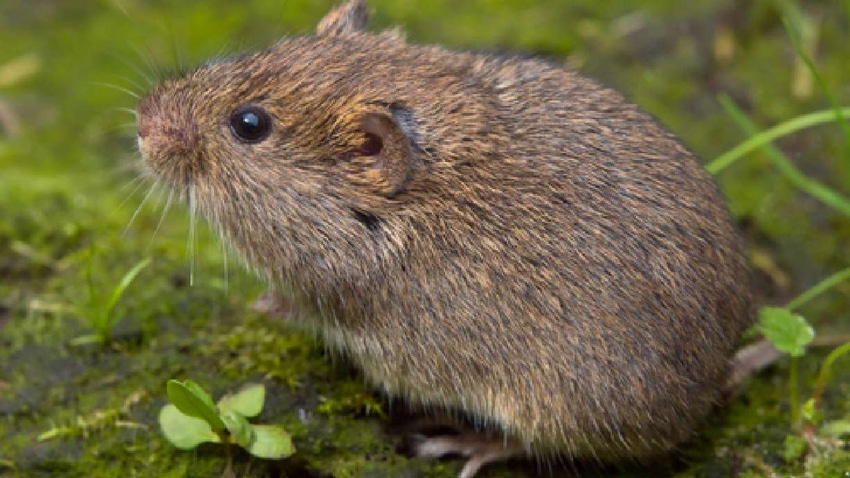April 17, 2023

A small, furry rodent – the vole – is showing up throughout Utah as this year’s record amount of snow melts. Orchards, residential lawns, pastures, and golf course lawns are feeling the brunt of the vole’s activity.
According to Terry Messmer, USU Extension wildlife specialist, voles are hands down the world’s most prolific mammals. Females can breed when they are a month old and produce litters of three to 10 pups every three weeks for the rest of their lives. They are also known for their boom-bust population cycles, with population levels peaking every two to five years.
“Voles pose no major public health problems because of infrequent contact with humans,” he said. “However, they can harbor infectious diseases like plague and tularemia. For this reason, wear protective leather gloves if handling them becomes necessary.”
Messmer said the gnaw marks and girdling damage voles cause are similar to many other species of wildlife, particularly rabbits. This, coupled with the vole’s small size and inconspicuous nature, often lead homeowners to believe another wildlife species causes vole damage. Vole girdling is characterized by non-uniform gnaw marks at various angles in irregular patches. In contrast, rabbits clip branches with neat, clean cuts. The gnaw marks left by voles are about 1/8 inch in width and 3/8 inch in length; gnaw marks caused by rabbits are usually larger. Careful examination of girdling damage can help identify the animal.
“The most prominent sign of vole damage in yards and fields is their extensive runway systems,” he said. “Runways are 1 to 2 inches in width, and vegetation is often close to the ground next to these well-traveled routes.”
Messmer said removing weeds, ground cover and litter around lawns and plantings can reduce habitat suitability for voles and help decrease their damage. Mulch should be cleared 3 feet or more from the base of trees. Soil cultivation destroys vole runway systems and may kill voles outright. Because of this, annual plant areas are often less susceptible to vole damage than perennial plant areas.
Cylinders made of hardware cloth (found at most hardware stores) can effectively discourage voles and protect individual plants. The mesh size of the cloth should be no larger than 1/4 inch. The cylinder should be buried at least 6 inches below the ground to ensure that voles will not burrow under it and get to the plant. This will protect individual plants, but fencing is often ineffective in covering large areas such as lawns, and it is also cost prohibitive.
“The EPA approves two chemicals for repelling voles,” Messmer said. “These two repellents may contain thiram, a fungicide, or capsaicin, the chemical that makes peppers ‘hot’ and alters the taste of plants, making them unpalatable to voles. Although these repellents may temporarily protect plants, their effectiveness is usually short-lived.”
Messmer said for fields and other large rural areas, the EPA currently approves two toxicants— zinc phosphide and anticoagulants. Of these, zinc phosphide (2 percent) is more commonly used and is available in pellet and grain bait formulas and is typically broadcast at 6 to 10 pounds per acre.
“Hand placing the bait in burrows and runways greatly reduces the risk to other species,” he said. “Zinc phosphide is toxic to humans when ingested and may be absorbed through the skin, so always wear gloves and safely dispose of it. Zinc phosphide is a restricted-use chemical, and those who apply it must be certified applicators.”
Baits effective
Messmer said anticoagulant baits are also effective in reducing voles.
“Approximately 95 percent of mice and rats are controlled with anticoagulants,” he said. “Anticoagulants can be broadcast over an area or placed in runways and burrows. Baits can be glued to the inside of a water-repellent paper tube. Anticoagulants work much slower than zinc phosphide, and death is delayed for several days following ingestion of a lethal dose. Anticoagulants can be toxic to humans and pets. Use caution in urban areas, and only deliver them using pet- and child-proof bait boxes. For these reasons, I would discourage using them where children and pets frequent.”
Messmer said that trapping voles can effectively control small vole populations, but it is not cost-effective in larger areas because of their high reproductive rates. If voles invade a house (which is unusual), remove them as you would house mice with snap traps or live traps.
For more information about vole baits and control, contact your local USU Extension office or visit http://extension.usu.edu/files/publications/publication/NR_WD_009.pdf.
Source: Utah State University Extension
You May Also Like




